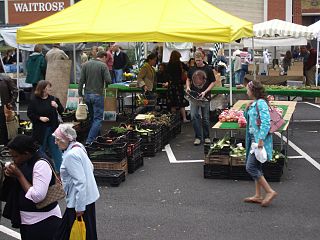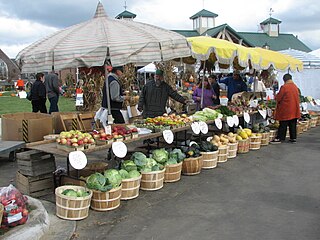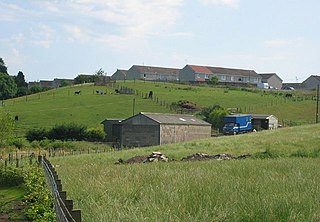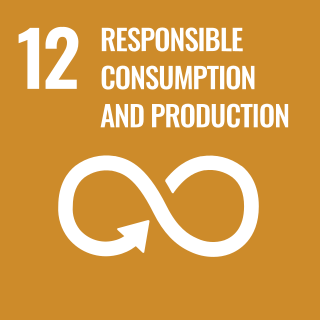Related Research Articles

Local food is food that is produced within a short distance of where it is consumed, often accompanied by a social structure and supply chain different from the large-scale supermarket system.

Community-supported agriculture or cropsharing is a system that connects producers and consumers within the food system closer by allowing the consumer to subscribe to the harvest of a certain farm or group of farms. It is an alternative socioeconomic model of agriculture and food distribution that allows the producer and consumer to share the risks of farming. The model is a subcategory of civic agriculture that has an overarching goal of strengthening a sense of community through local markets.

A farmers' market is a physical retail marketplace intended to sell foods directly by farmers to consumers. Farmers' markets may be indoors or outdoors and typically consist of booths, tables or stands where farmers sell their produce, live animals and plants, and sometimes prepared foods and beverages. Farmers' markets exist in many countries worldwide and reflect the local culture and economy. The size of the market may be just a few stalls or it may be as large as several city blocks. Due to their nature, they tend to be less rigidly regulated than retail produce shops.

Urban agriculture refers to various practices of cultivating, processing, and distributing food in urban areas. The term also applies to the area activities of animal husbandry, aquaculture, beekeeping, and horticulture in an urban context. Urban agriculture is distinguished from peri-urban agriculture, which takes place in rural areas at the edge of suburbs.
Agribusiness is the industry, enterprises, and the field of study of value chains in agriculture and in the bio-economy, in which case it is also called bio-business or bio-enterprise. The primary goal of agribusiness is to maximize profit while satisfying the needs of consumers for products related to natural resources such as biotechnology, farms, food, forestry, fisheries, fuel, and fiber.

A sustainable food system is a type of food system that provides healthy food to people and creates sustainable environmental, economic, and social systems that surround food. Sustainable food systems start with the development of sustainable agricultural practices, development of more sustainable food distribution systems, creation of sustainable diets, and reduction of food waste throughout the system. Sustainable food systems have been argued to be central to many or all 17 Sustainable Development Goals.

Benin is predominantly a rural society, and agriculture in Benin supports more than 70% of the population. Agriculture contributes around 35% of the country's gross domestic product (GDP) and 80% of export income. While the Government of Benin (GOB) aims to diversify its agricultural production, Benin remains underdeveloped, and its economy is underpinned by subsistence agriculture. Approximately 93% of total agricultural production goes into food production. The proportion of the population living in poverty is about 35.2%, with more rural households in poverty (38.4%) than urban households (29.8%). 36% of households depend solely upon agricultural (crop) production for income, and another 30% depend on crop production, livestock, or fishing for income.
Sustainable consumption is the use of products and services in ways that minimizes impacts on the environment.
The term food system describes the interconnected systems and processes that influence nutrition, food, health, community development, and agriculture. A food system includes all processes and infrastructure involved in feeding a population: growing, harvesting, processing, packaging, transporting, marketing, consumption, distribution, and disposal of food and food-related items. It also includes the inputs needed and outputs generated at each of these steps. Food systems fall within agri-food systems, which encompass the entire range of actors and their interlinked value-adding activities in the primary production of food and non-food agricultural products, as well as in food storage, aggregation, post-harvest handling, transportation, processing, distribution, marketing, disposal, and consumption. A food system operates within and is influenced by social, political, economic, technological and environmental contexts. It also requires human resources that provide labor, research and education. Food systems are either conventional or alternative according to their model of food lifespan from origin to plate. Food systems are dependent on a multitude of ecosystem services. For example, natural pest regulations, microorganisms providing nitrogen-fixation, and pollinators.

Agricultural marketing covers the services involved in moving an agricultural product from the farm to the consumer. These services involve the planning, organizing, directing and handling of agricultural produce in such a way as to satisfy farmers, intermediaries and consumers. Numerous interconnected activities are involved in doing this, such as planning production, growing and harvesting, grading, packing and packaging, transport, storage, agro- and food processing, provision of market information, distribution, advertising and sale. Effectively, the term encompasses the entire range of supply chain operations for agricultural products, whether conducted through ad hoc sales or through a more integrated chain, such as one involving contract farming.

Micro-sustainability is the portion of sustainability centered around small scale environmental measures that ultimately affect the environment through a larger cumulative impact. Micro-sustainability centers on individual efforts, behavior modification, education and creating attitudinal changes, which result in an environmentally conscious individual. Micro-sustainability encourages sustainable changes through "change agents"—individuals who foster positive environmental action locally and inside their sphere of influence. Examples of micro-sustainability include recycling, power saving by turning off unused lights, programming thermostats for efficient use of energy, reducing water usage, changing commuting habits to use less fossil fuels or modifying buying habits to reduce consumption and waste. The emphasis of micro-sustainability is on an individual's actions, rather than organizational or institutional practices at the systemic level. These small local level actions have immediate community benefits if undertaken on a widespread scale and if imitated, they can have a cumulative broad impact.
In the agricultural context, diversification can be regarded as the re-allocation of some of a farm's productive resources, such as land, capital, farm equipment and labour to other products and, particularly in richer countries, to non-farming activities such as restaurants and shops. Factors leading to decisions to diversify are many, but include: reducing risk, responding to changing consumer demands or changing government policy, responding to external shocks and, more recently, as a consequence of climate change.
Participatory Guarantee Systems (PGS), as defined by IFOAM, are "locally focused quality assurance systems. They certify producers based on active participation of stakeholders and are built on a foundation of trust, social networks and knowledge exchange." They represent an alternative to third party certification, especially adapted to local markets and short supply chains. They can also complement third party certification with a private label that brings additional guarantees and transparency. PGS enable the direct participation of producers, consumers and other stakeholders in:
Sustainability standards and certifications are voluntary guidelines used by producers, manufacturers, traders, retailers, and service providers to demonstrate their commitment to good environmental, social, ethical, and food safety practices. There are over 400 such standards across the world.
Sustainable products are products who are either sustainability sourced, manufactured or processed that provide environmental, social and economic benefits while protecting public health and environment over their whole life cycle, from the extraction of raw materials until the final disposal.

Peri-urban regions can be defined as 'superficial' rural areas that are within the orbit of immediate urban hubs, in other words, areas that surround large population centers. These regions can also be referred to as 'exurban areas', 'the rural-urban fringe' or the 'fringe', they include the transition zones between the outer limits of the commuter belt and the edge of newly constructed suburban areas.

Sustainable Development Goal 12, titled "responsible consumption and production", is one of the 17 Sustainable Development Goals established by the United Nations in 2015. The official wording of SDG 12 is "Ensure sustainable consumption and production patterns". SDG 12 is meant to ensure good use of resources, improve energy efficiency and sustainable infrastructure, provide access to basic services, create green and decent jobs, and ensure a better quality of life for all. SDG 12 has 11 targets to be achieved by at least 2030, and progress towards the targets is measured using 13 indicators.

Sustainable Development Goal 2 aims to achieve "zero hunger". It is one of the 17 Sustainable Development Goals established by the United Nations in 2015. The official wording is: "End hunger, achieve food security and improved nutrition and promote sustainable agriculture". SDG 2 highlights the "complex inter-linkages between food security, nutrition, rural transformation and sustainable agriculture". According to the United Nations, there are around 690 million people who are hungry, which accounts for slightly less than 10 percent of the world population. One in every nine people goes to bed hungry each night, including 20 million people currently at risk of famine in South Sudan, Somalia, Yemen and Nigeria.
Globalization of supply chains and pressure to lower production costs have negatively impacted environments and communities around the world, especially in developing nations where production of high demand goods is increasingly taking place. Since the 1990s, awareness of these negative impacts has grown, leading stakeholders to push companies to take responsibility and actively work to improve the sustainability of their supply chains. It has come to be understood that a company is only as sustainable as the start of its supply chain, bringing about the need for sustainable sourcing. Sustainable sourcing refers to the inclusion of social, environmental, and economic criteria in the sourcing process.
The Food Bank of Indonesia is a non-profit foundation operating in the social sector. Located in Jakarta, the Food Bank of Indonesia is the first food bank in the country actively working to provide access to food and eradicate hunger in various regions across Indonesia. FOI also supports the country in achieving Sustainable Development Goals (SDGs), by promoting food sovereignty and implementing responsible patterns of production and consumption.
References
- ↑ Van Der Ploeg, Jan Douwe, Henk Renting, Gianluca Brunori, Karlheinz Knickel, Joe Mannion, Terry Marsden, and others, “Rural Development: From Practices and Policies Towards Theory”, Sociologia Ruralis, 40 (2000), 391–408 <doi:10.1111/1467-9523.00156>
- 1 2 3 4 5 6 7 8 9 10 Balcom, Rebecca; Abebe, Gumataw Kifle; Yiridoe, Emmanuel K.; Hartt, Christopher M. (2023). "Sustainable production and distribution practices in Atlantic Canadian short food supply chains: Explorative study". Frontiers in Sustainable Food Systems. 7. doi: 10.3389/fsufs.2023.1121006 .
- ↑ "Conference "Local agriculture and short food supply chains" (Brussels, 20/04/2012) - Agriculture and rural development". Ec.europa.eu. Retrieved 2012-10-23.
- 1 2 Ilbery, B., and D. Maye, 2005. "Alternative (shorter) food supply chains and specialist livestock products in the Scottish-English borders", Environment and planning, A 37 (5): 823–844.
- ↑ Goodman, D., and M. Goodman. 2008. «Alternative food networks». International encyclopedia of human geography, pp.(Oxford: Elsevier).
- ↑ Roep, D., and H. Wiskerke. 2006. Nourishing networks: fourteen lessons about creating sustainable food supply chains. Reed Business Information, Wageningen University.
- 1 2 3 Renting H., Marsden T., Banks J. (2003) Understanding alternative food networks: exploring the role of short food supply chains in rural development. Environment and Planning A 2003, volume 35, pages 393–411
- 1 2 Marsden, T., Banks, J. and Bristow, G., (2000), «Food supply chain approaches: exploring their role in rural development». Sociologia ruralis 40 (4): 424–438.
- ↑ Bayir, Bilgesu; Charles, Aurélie; Sekhari, Aicha; Ouzrout, Yacine (2022). "Issues and Challenges in Short Food Supply Chains: A Systematic Literature Review". Sustainability. 14 (5): 3029. doi: 10.3390/su14053029 .
- 1 2 Kebir, L. and Torre A. (2012) Geographical proximity and new short food supply chains. In: Lazzeretti, Luciana (ed.) 2012. Creative Industries and Innovation in Europe: Concepts, Measures and Comparative Case Studies. Routledge.
- 1 2 3 Gori, Francesca; Castellini, Alessandra. "Alternative Food Networks and Short Food Supply Chains: A Systematic Literature Review Based on a Case Study Approach" . Retrieved April 17, 2023.
- 1 2 3 4 Petruzzelli, M.; Ihle, R.; Colitti, S.; Vittuari, M. (October 2023). "The role of short food supply chains in advancing the global agenda for sustainable food systems transitions". Cities. 141: 104496. doi:10.1016/j.cities.2023.104496. hdl: 11585/935513 . ISSN 0264-2751.
- 1 2 3 4 5 6 Michel-Villarreal, Rosario (2023). "Towards sustainable and resilient short food supply chains: a focus on sustainability practices and resilience capabilities using case study". British Food Journal. 125 (5): 1914–1935. doi:10.1108/BFJ-09-2021-1060.
- ↑ Sachs, Jeffrey D.; Schmidt-Traub, Guido; Mazzucato, Mariana; Messner, Dirk; Nakicenovic, Nebojsa; Rockström, Johan (September 2019). "Six Transformations to achieve the Sustainable Development Goals". Nature Sustainability. 2 (9): 805–814. Bibcode:2019NatSu...2..805S. doi:10.1038/s41893-019-0352-9. ISSN 2398-9629.
- 1 2 3 Morrison, Jamie (2019). "FAO framework for the Urban Food Agenda [In Brief]" (PDF).
- ↑ "Milan Urban Food Policy Pact" (PDF). 2015.
- ↑ Cohen, Nevin (2022-04-05). "Roles of Cities in Creating Healthful Food Systems". Annual Review of Public Health. 43 (1): 419–437. doi: 10.1146/annurev-publhealth-052220-021059 . ISSN 0163-7525. PMID 34936824.
- ↑ FAO (2018). "The Milan Urban Food Policy Pact Monitoring Framework" (PDF).
- ↑ von Braun, Joachim; Afsana, Kaosar; Fresco, Louise O.; Hassan, Mohamed; Torero, Maximo (2021). "Food Systems – Definition, Concept and Application for the UN Food Systems Summit" (PDF).
- ↑ Jarzębowski, Sebastian; Bourlakis, Michael; Bezat-Jarzębowska, Agnieszka (January 2020). "Short Food Supply Chains (SFSC) as Local and Sustainable Systems". Sustainability. 12 (11): 4715. doi: 10.3390/su12114715 . ISSN 2071-1050.
- 1 2 Belletti, Giovanni; Marescotti, Andrea (2020). "Short Food Supply Chains For Promoting Local Food On Local Markets" (PDF).
- ↑ Guildford Borough Council, Farmers' Market, accessed 20 January 2021
- ↑ Craven, Teri J.; Krejci, Caroline C.; Mittal, Anuj (January 2018). "Logistics Best Practices for Regional Food Systems: A Review". Sustainability. 10 (1): 168. doi: 10.3390/su10010168 .